Organisational Behaviour Project: Culture, Power and Politics
VerifiedAdded on 2023/01/11
|20
|5931
|61
Project
AI Summary
This project delves into the realm of organisational behaviour, focusing on Marks and Spencer (M&S). It examines the impact of organizational culture, politics, and power dynamics on individual and team performance, exploring how these factors shape employee behaviour. The project analyzes M&S's organizational culture using Handy's model, discussing power, role, task, and person cultures. It also investigates organizational politics, including personal, decisional, structural, and change-related aspects, and how these influence employee performance. Furthermore, the project explores French and Raven's power model, highlighting reward, expert, legitimate, coercive, and referent power. The report also covers motivation theories, such as process theories (Adams' Equity model) and goal-setting theory, along with motivation techniques like reward strategies, communication skills, emotional intelligence, and flexible working hours. It then differentiates between effective and ineffective teams, providing insights into team dynamics. Finally, the project applies concepts and philosophies of organisational behaviour to a business situation, ultimately aiming to provide strategies for enhanced organizational effectiveness at Marks and Spencer.
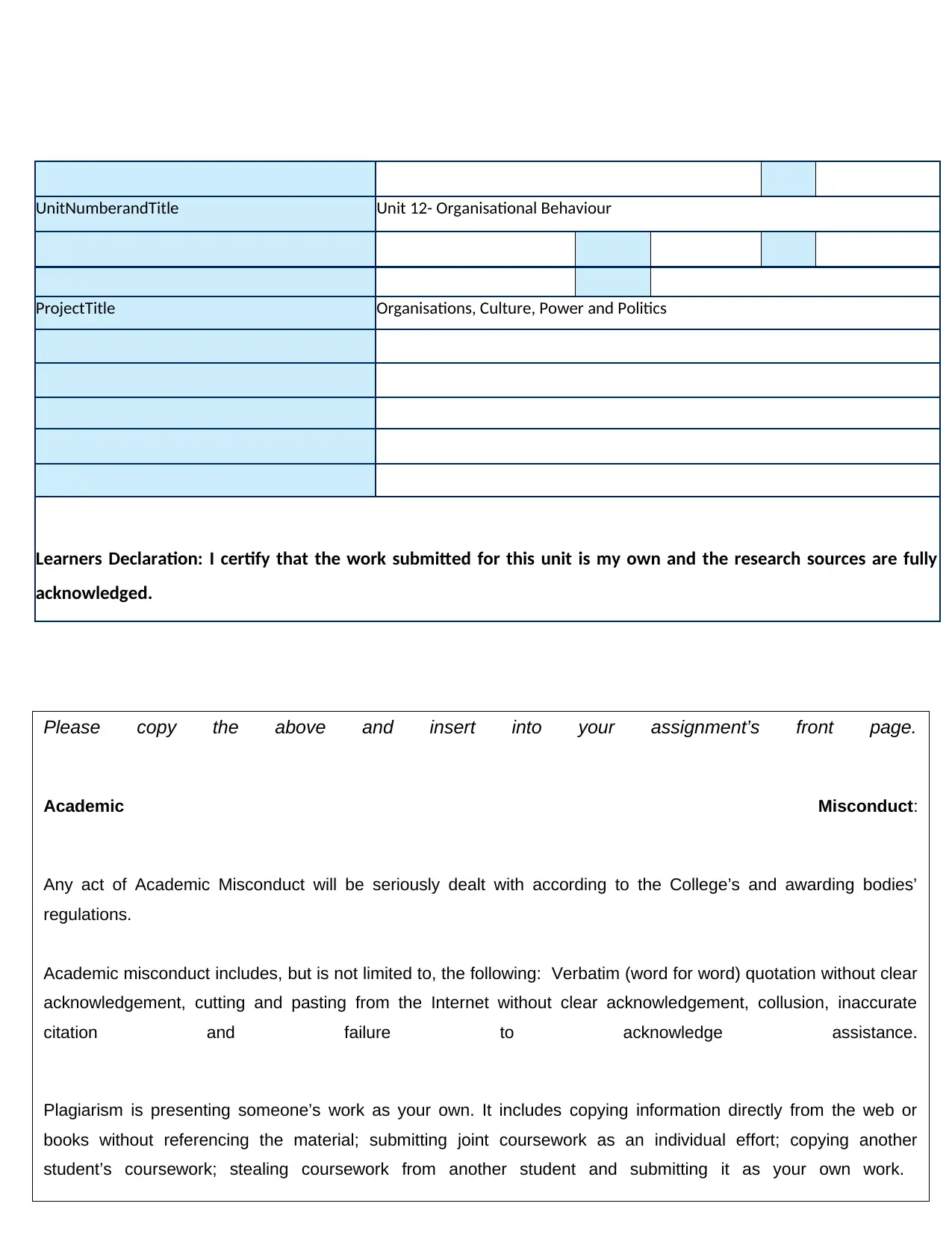
UnitNumberandTitle Unit 12- Organisational Behaviour
ProjectTitle Organisations, Culture, Power and Politics
Learners Declaration: I certify that the work submitted for this unit is my own and the research sources are fully
acknowledged.
Please copy the above and insert into your assignment’s front page.
Academic Misconduct:
Any act of Academic Misconduct will be seriously dealt with according to the College’s and awarding bodies’
regulations.
Academic misconduct includes, but is not limited to, the following: Verbatim (word for word) quotation without clear
acknowledgement, cutting and pasting from the Internet without clear acknowledgement, collusion, inaccurate
citation and failure to acknowledge assistance.
Plagiarism is presenting someone’s work as your own. It includes copying information directly from the web or
books without referencing the material; submitting joint coursework as an individual effort; copying another
student’s coursework; stealing coursework from another student and submitting it as your own work.
ProjectTitle Organisations, Culture, Power and Politics
Learners Declaration: I certify that the work submitted for this unit is my own and the research sources are fully
acknowledged.
Please copy the above and insert into your assignment’s front page.
Academic Misconduct:
Any act of Academic Misconduct will be seriously dealt with according to the College’s and awarding bodies’
regulations.
Academic misconduct includes, but is not limited to, the following: Verbatim (word for word) quotation without clear
acknowledgement, cutting and pasting from the Internet without clear acknowledgement, collusion, inaccurate
citation and failure to acknowledge assistance.
Plagiarism is presenting someone’s work as your own. It includes copying information directly from the web or
books without referencing the material; submitting joint coursework as an individual effort; copying another
student’s coursework; stealing coursework from another student and submitting it as your own work.
Paraphrase This Document
Need a fresh take? Get an instant paraphrase of this document with our AI Paraphraser
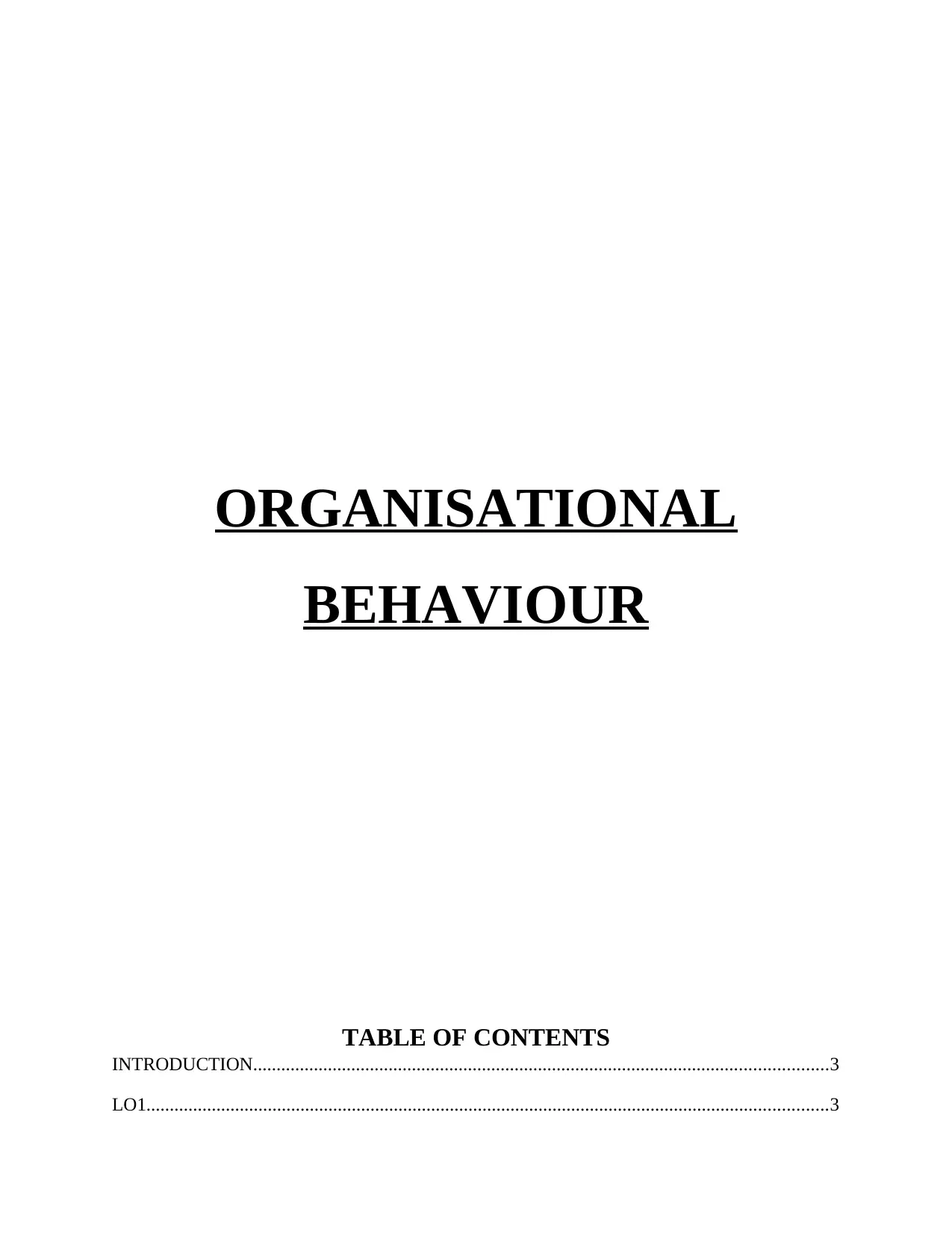
ORGANISATIONAL
BEHAVIOUR
TABLE OF CONTENTS
INTRODUCTION...........................................................................................................................3
LO1..................................................................................................................................................3
BEHAVIOUR
TABLE OF CONTENTS
INTRODUCTION...........................................................................................................................3
LO1..................................................................................................................................................3
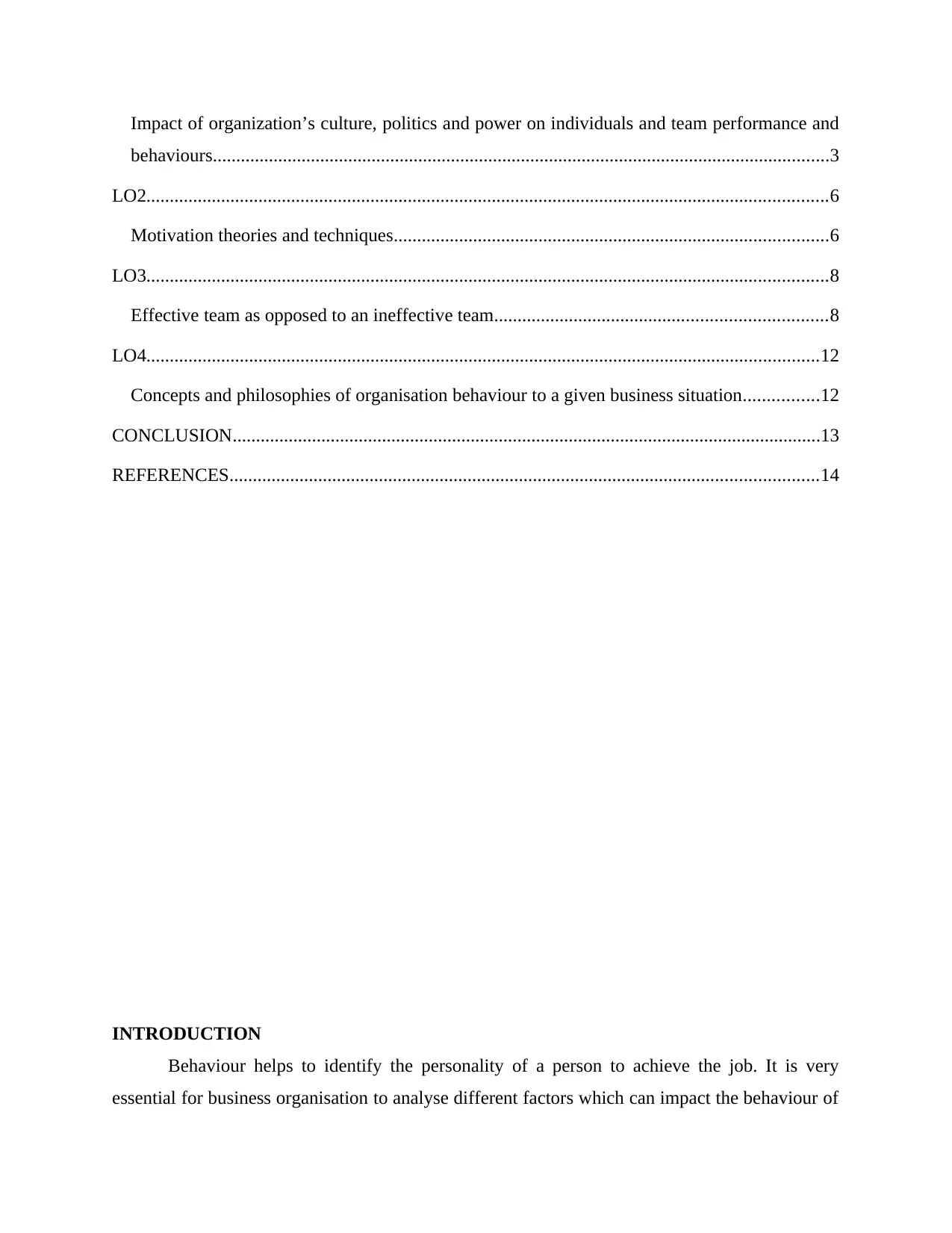
Impact of organization’s culture, politics and power on individuals and team performance and
behaviours....................................................................................................................................3
LO2..................................................................................................................................................6
Motivation theories and techniques.............................................................................................6
LO3..................................................................................................................................................8
Effective team as opposed to an ineffective team.......................................................................8
LO4................................................................................................................................................12
Concepts and philosophies of organisation behaviour to a given business situation................12
CONCLUSION..............................................................................................................................13
REFERENCES..............................................................................................................................14
INTRODUCTION
Behaviour helps to identify the personality of a person to achieve the job. It is very
essential for business organisation to analyse different factors which can impact the behaviour of
behaviours....................................................................................................................................3
LO2..................................................................................................................................................6
Motivation theories and techniques.............................................................................................6
LO3..................................................................................................................................................8
Effective team as opposed to an ineffective team.......................................................................8
LO4................................................................................................................................................12
Concepts and philosophies of organisation behaviour to a given business situation................12
CONCLUSION..............................................................................................................................13
REFERENCES..............................................................................................................................14
INTRODUCTION
Behaviour helps to identify the personality of a person to achieve the job. It is very
essential for business organisation to analyse different factors which can impact the behaviour of
⊘ This is a preview!⊘
Do you want full access?
Subscribe today to unlock all pages.

Trusted by 1+ million students worldwide
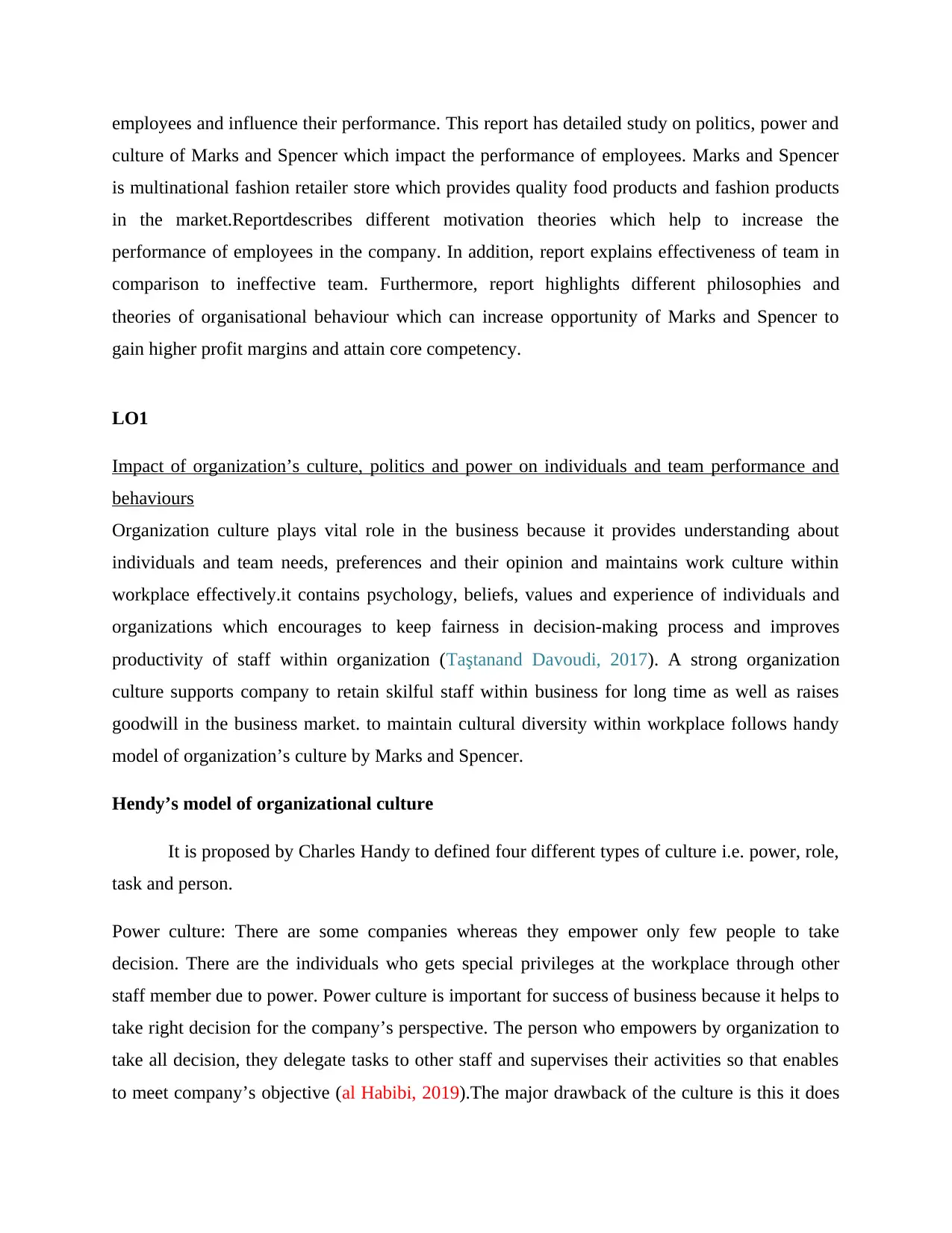
employees and influence their performance. This report has detailed study on politics, power and
culture of Marks and Spencer which impact the performance of employees. Marks and Spencer
is multinational fashion retailer store which provides quality food products and fashion products
in the market.Reportdescribes different motivation theories which help to increase the
performance of employees in the company. In addition, report explains effectiveness of team in
comparison to ineffective team. Furthermore, report highlights different philosophies and
theories of organisational behaviour which can increase opportunity of Marks and Spencer to
gain higher profit margins and attain core competency.
LO1
Impact of organization’s culture, politics and power on individuals and team performance and
behaviours
Organization culture plays vital role in the business because it provides understanding about
individuals and team needs, preferences and their opinion and maintains work culture within
workplace effectively.it contains psychology, beliefs, values and experience of individuals and
organizations which encourages to keep fairness in decision-making process and improves
productivity of staff within organization (Taştanand Davoudi, 2017). A strong organization
culture supports company to retain skilful staff within business for long time as well as raises
goodwill in the business market. to maintain cultural diversity within workplace follows handy
model of organization’s culture by Marks and Spencer.
Hendy’s model of organizational culture
It is proposed by Charles Handy to defined four different types of culture i.e. power, role,
task and person.
Power culture: There are some companies whereas they empower only few people to take
decision. There are the individuals who gets special privileges at the workplace through other
staff member due to power. Power culture is important for success of business because it helps to
take right decision for the company’s perspective. The person who empowers by organization to
take all decision, they delegate tasks to other staff and supervises their activities so that enables
to meet company’s objective (al Habibi, 2019).The major drawback of the culture is this it does
culture of Marks and Spencer which impact the performance of employees. Marks and Spencer
is multinational fashion retailer store which provides quality food products and fashion products
in the market.Reportdescribes different motivation theories which help to increase the
performance of employees in the company. In addition, report explains effectiveness of team in
comparison to ineffective team. Furthermore, report highlights different philosophies and
theories of organisational behaviour which can increase opportunity of Marks and Spencer to
gain higher profit margins and attain core competency.
LO1
Impact of organization’s culture, politics and power on individuals and team performance and
behaviours
Organization culture plays vital role in the business because it provides understanding about
individuals and team needs, preferences and their opinion and maintains work culture within
workplace effectively.it contains psychology, beliefs, values and experience of individuals and
organizations which encourages to keep fairness in decision-making process and improves
productivity of staff within organization (Taştanand Davoudi, 2017). A strong organization
culture supports company to retain skilful staff within business for long time as well as raises
goodwill in the business market. to maintain cultural diversity within workplace follows handy
model of organization’s culture by Marks and Spencer.
Hendy’s model of organizational culture
It is proposed by Charles Handy to defined four different types of culture i.e. power, role,
task and person.
Power culture: There are some companies whereas they empower only few people to take
decision. There are the individuals who gets special privileges at the workplace through other
staff member due to power. Power culture is important for success of business because it helps to
take right decision for the company’s perspective. The person who empowers by organization to
take all decision, they delegate tasks to other staff and supervises their activities so that enables
to meet company’s objective (al Habibi, 2019).The major drawback of the culture is this it does
Paraphrase This Document
Need a fresh take? Get an instant paraphrase of this document with our AI Paraphraser
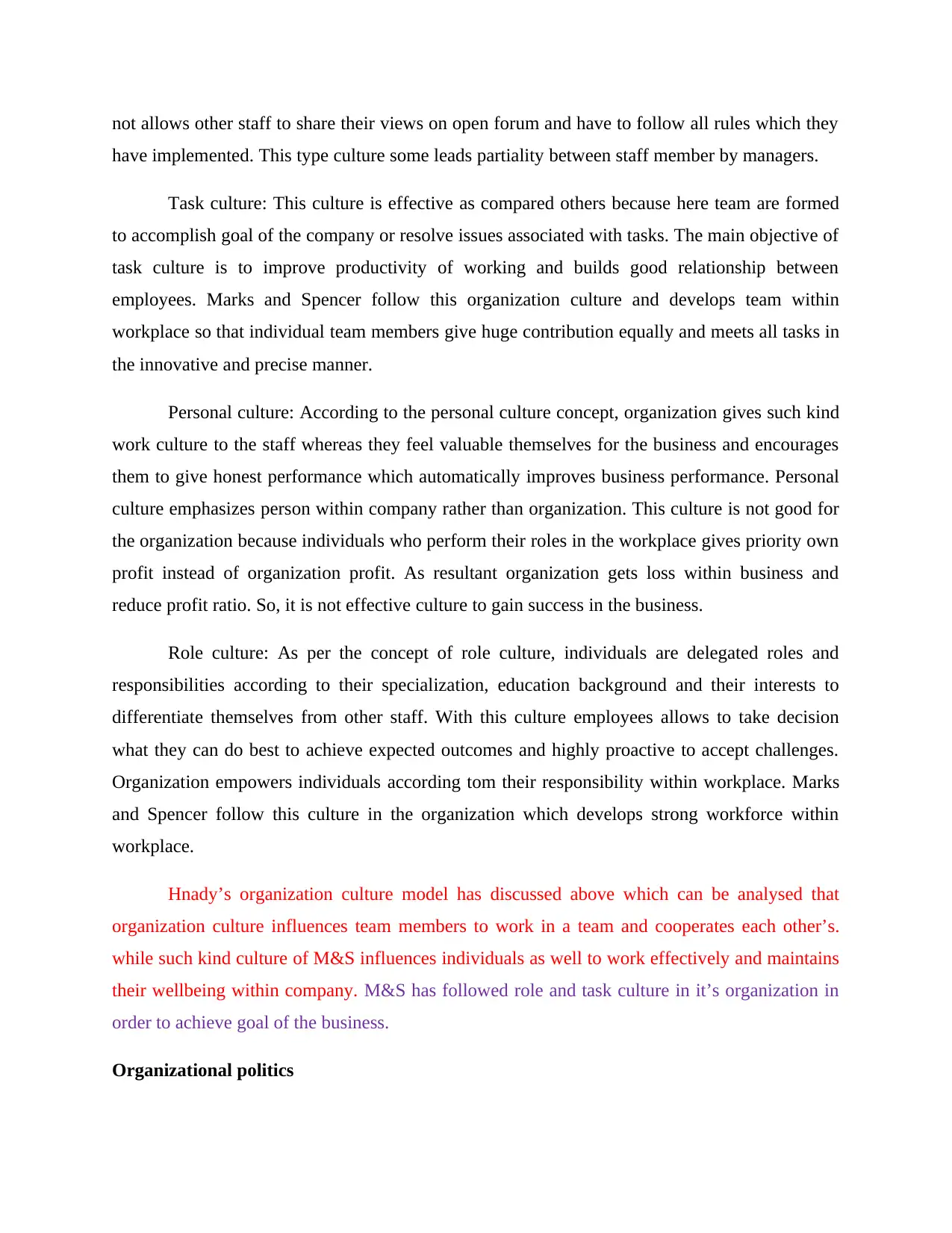
not allows other staff to share their views on open forum and have to follow all rules which they
have implemented. This type culture some leads partiality between staff member by managers.
Task culture: This culture is effective as compared others because here team are formed
to accomplish goal of the company or resolve issues associated with tasks. The main objective of
task culture is to improve productivity of working and builds good relationship between
employees. Marks and Spencer follow this organization culture and develops team within
workplace so that individual team members give huge contribution equally and meets all tasks in
the innovative and precise manner.
Personal culture: According to the personal culture concept, organization gives such kind
work culture to the staff whereas they feel valuable themselves for the business and encourages
them to give honest performance which automatically improves business performance. Personal
culture emphasizes person within company rather than organization. This culture is not good for
the organization because individuals who perform their roles in the workplace gives priority own
profit instead of organization profit. As resultant organization gets loss within business and
reduce profit ratio. So, it is not effective culture to gain success in the business.
Role culture: As per the concept of role culture, individuals are delegated roles and
responsibilities according to their specialization, education background and their interests to
differentiate themselves from other staff. With this culture employees allows to take decision
what they can do best to achieve expected outcomes and highly proactive to accept challenges.
Organization empowers individuals according tom their responsibility within workplace. Marks
and Spencer follow this culture in the organization which develops strong workforce within
workplace.
Hnady’s organization culture model has discussed above which can be analysed that
organization culture influences team members to work in a team and cooperates each other’s.
while such kind culture of M&S influences individuals as well to work effectively and maintains
their wellbeing within company. M&S has followed role and task culture in it’s organization in
order to achieve goal of the business.
Organizational politics
have implemented. This type culture some leads partiality between staff member by managers.
Task culture: This culture is effective as compared others because here team are formed
to accomplish goal of the company or resolve issues associated with tasks. The main objective of
task culture is to improve productivity of working and builds good relationship between
employees. Marks and Spencer follow this organization culture and develops team within
workplace so that individual team members give huge contribution equally and meets all tasks in
the innovative and precise manner.
Personal culture: According to the personal culture concept, organization gives such kind
work culture to the staff whereas they feel valuable themselves for the business and encourages
them to give honest performance which automatically improves business performance. Personal
culture emphasizes person within company rather than organization. This culture is not good for
the organization because individuals who perform their roles in the workplace gives priority own
profit instead of organization profit. As resultant organization gets loss within business and
reduce profit ratio. So, it is not effective culture to gain success in the business.
Role culture: As per the concept of role culture, individuals are delegated roles and
responsibilities according to their specialization, education background and their interests to
differentiate themselves from other staff. With this culture employees allows to take decision
what they can do best to achieve expected outcomes and highly proactive to accept challenges.
Organization empowers individuals according tom their responsibility within workplace. Marks
and Spencer follow this culture in the organization which develops strong workforce within
workplace.
Hnady’s organization culture model has discussed above which can be analysed that
organization culture influences team members to work in a team and cooperates each other’s.
while such kind culture of M&S influences individuals as well to work effectively and maintains
their wellbeing within company. M&S has followed role and task culture in it’s organization in
order to achieve goal of the business.
Organizational politics

It is informal ways or activities that uses by organization to improve organization’s
productivity, performance and operation in the business market. It plays vital role in the
organization because it creates self-serving behaviour in individuals which they apply to
influence their performance and possibilities of achieving positive outcomes within company.
There are four types of organizational politics i.e. personal, decisional, structural and
organizational change etc. takes place in the workplace to improve working performance of
individuals. Personal politics generally takes place among staff for the promotion and
recognition perspective. This type politic practices by individuals within workplace to get upper
position from existing one. Such kind politics helps to improve individual’s competency level as
well as improves creative working environment within workplace (Pradhanand Mishra, 2019).
Decisional politic is generally practices by management to generate profitability within
company. Therefore, management invites staff to involve and keeps their viewpoints in decision-
making process so that individuals feel valuable themselves in the organization and it builds
strong relationship between management and staff. this politics helps management to negotiate
staff to accept organizational change and leads success within company. With structural politics
organization empowers it’s staff by delegating responsibility which influences individuals to
give effective performance on their level. Organizational structure politics develops a system
within organization and differentiates individuals’ roles and responsibility effectively.
Organizational change is also classified into politics whereas human resource managers sets goal
of the company and implements decision to achieve goal of the company effectively in the non-
favouritism market environment. Management practices leadership approach to influence their
team members for accepting change and improves productivity in their working by conducting
training and development program. Leadership approach is the part of politics so that they can
retain its staff within organization. The major drawbacks of the politics are that, such kind
politics often reluctant relationship between management and staff and raises conflicts crisis
among them. Marks and Spencer follow all above politics to achieve profitability in the company
which influences individuals to work effectively within organization.
Organizational power
French and Revan’s organization power model that is used to understand about power
and it’stypes which are practices byseniors authorities in the company to coordinate and control
productivity, performance and operation in the business market. It plays vital role in the
organization because it creates self-serving behaviour in individuals which they apply to
influence their performance and possibilities of achieving positive outcomes within company.
There are four types of organizational politics i.e. personal, decisional, structural and
organizational change etc. takes place in the workplace to improve working performance of
individuals. Personal politics generally takes place among staff for the promotion and
recognition perspective. This type politic practices by individuals within workplace to get upper
position from existing one. Such kind politics helps to improve individual’s competency level as
well as improves creative working environment within workplace (Pradhanand Mishra, 2019).
Decisional politic is generally practices by management to generate profitability within
company. Therefore, management invites staff to involve and keeps their viewpoints in decision-
making process so that individuals feel valuable themselves in the organization and it builds
strong relationship between management and staff. this politics helps management to negotiate
staff to accept organizational change and leads success within company. With structural politics
organization empowers it’s staff by delegating responsibility which influences individuals to
give effective performance on their level. Organizational structure politics develops a system
within organization and differentiates individuals’ roles and responsibility effectively.
Organizational change is also classified into politics whereas human resource managers sets goal
of the company and implements decision to achieve goal of the company effectively in the non-
favouritism market environment. Management practices leadership approach to influence their
team members for accepting change and improves productivity in their working by conducting
training and development program. Leadership approach is the part of politics so that they can
retain its staff within organization. The major drawbacks of the politics are that, such kind
politics often reluctant relationship between management and staff and raises conflicts crisis
among them. Marks and Spencer follow all above politics to achieve profitability in the company
which influences individuals to work effectively within organization.
Organizational power
French and Revan’s organization power model that is used to understand about power
and it’stypes which are practices byseniors authorities in the company to coordinate and control
⊘ This is a preview!⊘
Do you want full access?
Subscribe today to unlock all pages.

Trusted by 1+ million students worldwide
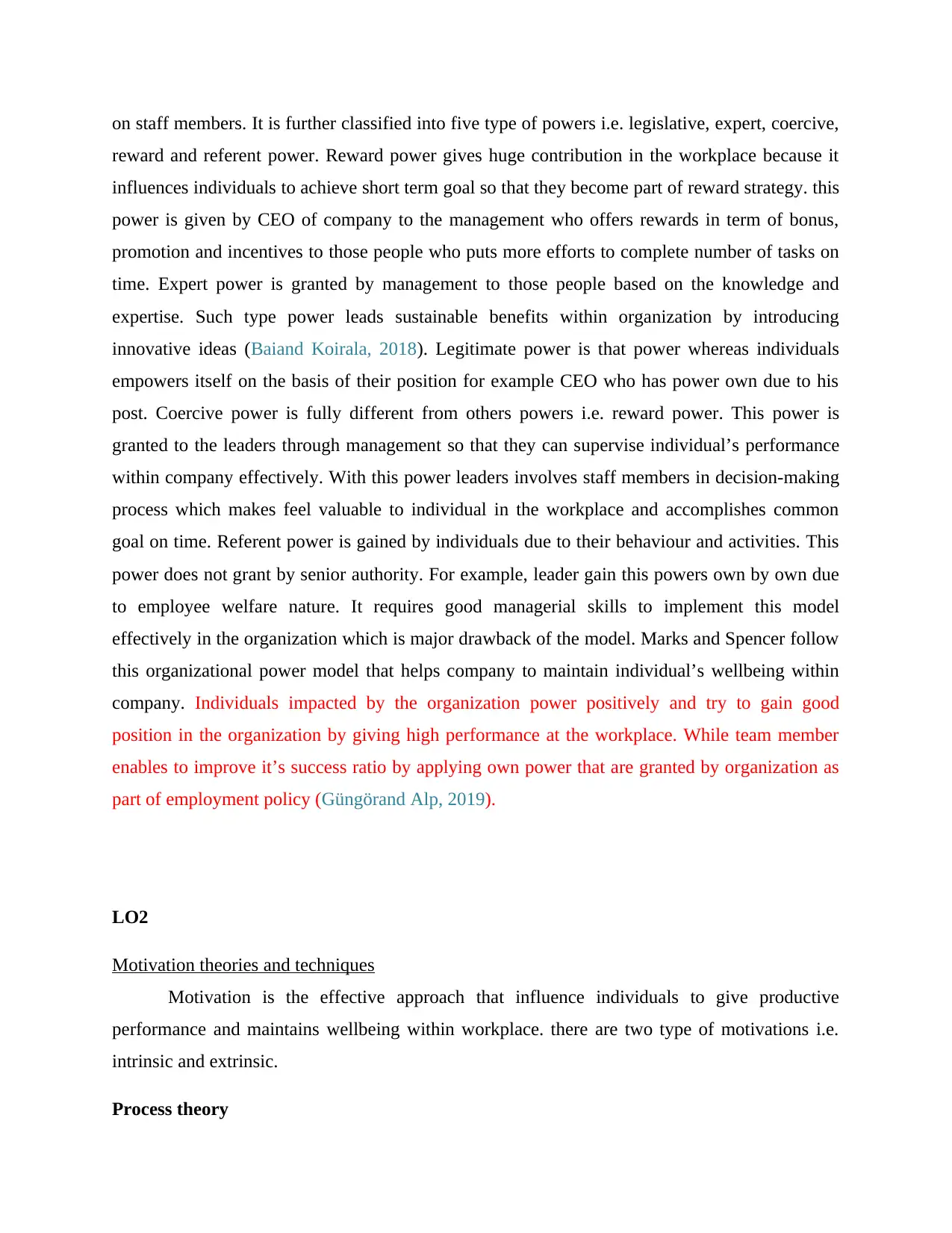
on staff members. It is further classified into five type of powers i.e. legislative, expert, coercive,
reward and referent power. Reward power gives huge contribution in the workplace because it
influences individuals to achieve short term goal so that they become part of reward strategy. this
power is given by CEO of company to the management who offers rewards in term of bonus,
promotion and incentives to those people who puts more efforts to complete number of tasks on
time. Expert power is granted by management to those people based on the knowledge and
expertise. Such type power leads sustainable benefits within organization by introducing
innovative ideas (Baiand Koirala, 2018). Legitimate power is that power whereas individuals
empowers itself on the basis of their position for example CEO who has power own due to his
post. Coercive power is fully different from others powers i.e. reward power. This power is
granted to the leaders through management so that they can supervise individual’s performance
within company effectively. With this power leaders involves staff members in decision-making
process which makes feel valuable to individual in the workplace and accomplishes common
goal on time. Referent power is gained by individuals due to their behaviour and activities. This
power does not grant by senior authority. For example, leader gain this powers own by own due
to employee welfare nature. It requires good managerial skills to implement this model
effectively in the organization which is major drawback of the model. Marks and Spencer follow
this organizational power model that helps company to maintain individual’s wellbeing within
company. Individuals impacted by the organization power positively and try to gain good
position in the organization by giving high performance at the workplace. While team member
enables to improve it’s success ratio by applying own power that are granted by organization as
part of employment policy (Güngörand Alp, 2019).
LO2
Motivation theories and techniques
Motivation is the effective approach that influence individuals to give productive
performance and maintains wellbeing within workplace. there are two type of motivations i.e.
intrinsic and extrinsic.
Process theory
reward and referent power. Reward power gives huge contribution in the workplace because it
influences individuals to achieve short term goal so that they become part of reward strategy. this
power is given by CEO of company to the management who offers rewards in term of bonus,
promotion and incentives to those people who puts more efforts to complete number of tasks on
time. Expert power is granted by management to those people based on the knowledge and
expertise. Such type power leads sustainable benefits within organization by introducing
innovative ideas (Baiand Koirala, 2018). Legitimate power is that power whereas individuals
empowers itself on the basis of their position for example CEO who has power own due to his
post. Coercive power is fully different from others powers i.e. reward power. This power is
granted to the leaders through management so that they can supervise individual’s performance
within company effectively. With this power leaders involves staff members in decision-making
process which makes feel valuable to individual in the workplace and accomplishes common
goal on time. Referent power is gained by individuals due to their behaviour and activities. This
power does not grant by senior authority. For example, leader gain this powers own by own due
to employee welfare nature. It requires good managerial skills to implement this model
effectively in the organization which is major drawback of the model. Marks and Spencer follow
this organizational power model that helps company to maintain individual’s wellbeing within
company. Individuals impacted by the organization power positively and try to gain good
position in the organization by giving high performance at the workplace. While team member
enables to improve it’s success ratio by applying own power that are granted by organization as
part of employment policy (Güngörand Alp, 2019).
LO2
Motivation theories and techniques
Motivation is the effective approach that influence individuals to give productive
performance and maintains wellbeing within workplace. there are two type of motivations i.e.
intrinsic and extrinsic.
Process theory
Paraphrase This Document
Need a fresh take? Get an instant paraphrase of this document with our AI Paraphraser
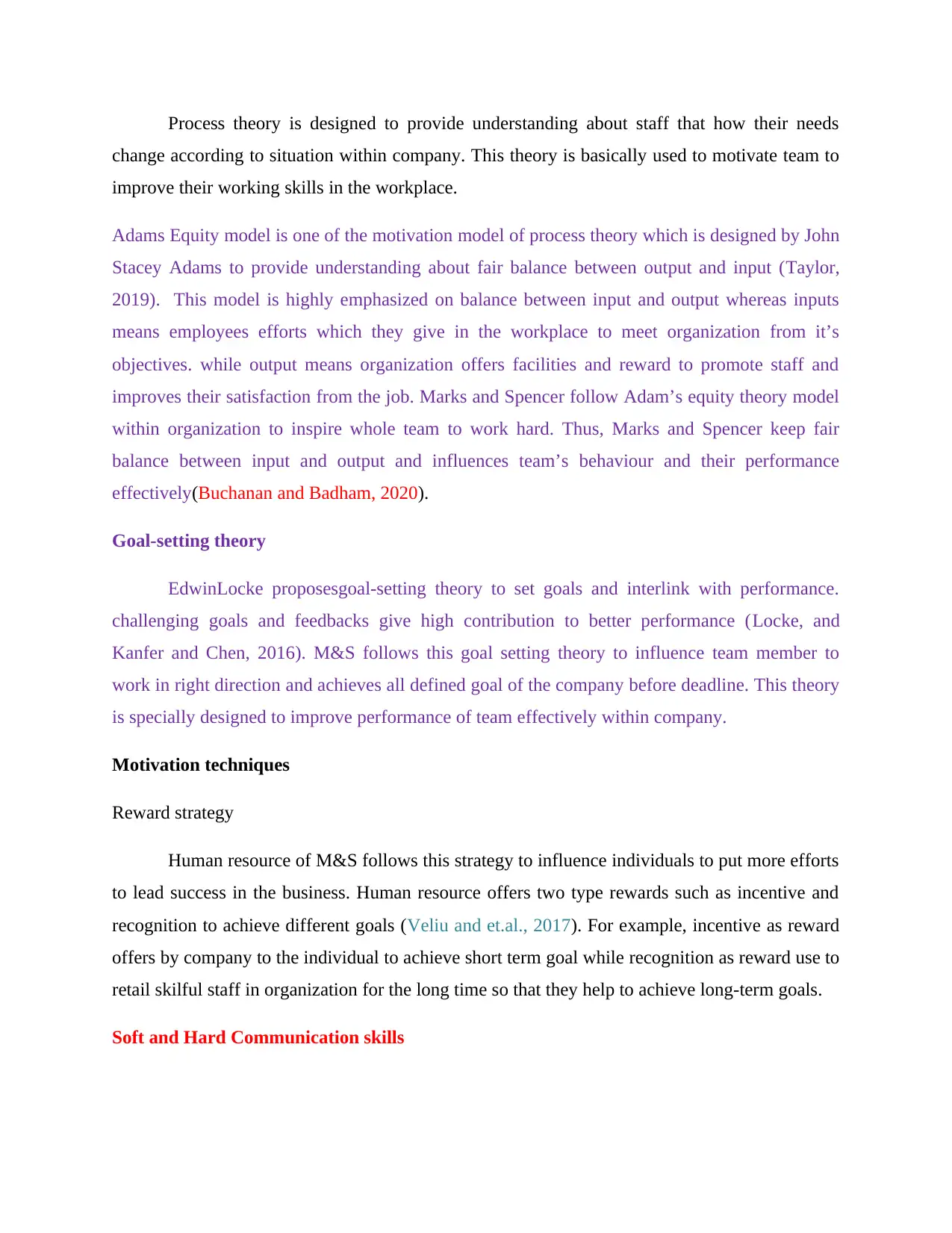
Process theory is designed to provide understanding about staff that how their needs
change according to situation within company. This theory is basically used to motivate team to
improve their working skills in the workplace.
Adams Equity model is one of the motivation model of process theory which is designed by John
Stacey Adams to provide understanding about fair balance between output and input (Taylor,
2019). This model is highly emphasized on balance between input and output whereas inputs
means employees efforts which they give in the workplace to meet organization from it’s
objectives. while output means organization offers facilities and reward to promote staff and
improves their satisfaction from the job. Marks and Spencer follow Adam’s equity theory model
within organization to inspire whole team to work hard. Thus, Marks and Spencer keep fair
balance between input and output and influences team’s behaviour and their performance
effectively(Buchanan and Badham, 2020).
Goal-setting theory
EdwinLocke proposesgoal-setting theory to set goals and interlink with performance.
challenging goals and feedbacks give high contribution to better performance (Locke, and
Kanfer and Chen, 2016). M&S follows this goal setting theory to influence team member to
work in right direction and achieves all defined goal of the company before deadline. This theory
is specially designed to improve performance of team effectively within company.
Motivation techniques
Reward strategy
Human resource of M&S follows this strategy to influence individuals to put more efforts
to lead success in the business. Human resource offers two type rewards such as incentive and
recognition to achieve different goals (Veliu and et.al., 2017). For example, incentive as reward
offers by company to the individual to achieve short term goal while recognition as reward use to
retail skilful staff in organization for the long time so that they help to achieve long-term goals.
Soft and Hard Communication skills
change according to situation within company. This theory is basically used to motivate team to
improve their working skills in the workplace.
Adams Equity model is one of the motivation model of process theory which is designed by John
Stacey Adams to provide understanding about fair balance between output and input (Taylor,
2019). This model is highly emphasized on balance between input and output whereas inputs
means employees efforts which they give in the workplace to meet organization from it’s
objectives. while output means organization offers facilities and reward to promote staff and
improves their satisfaction from the job. Marks and Spencer follow Adam’s equity theory model
within organization to inspire whole team to work hard. Thus, Marks and Spencer keep fair
balance between input and output and influences team’s behaviour and their performance
effectively(Buchanan and Badham, 2020).
Goal-setting theory
EdwinLocke proposesgoal-setting theory to set goals and interlink with performance.
challenging goals and feedbacks give high contribution to better performance (Locke, and
Kanfer and Chen, 2016). M&S follows this goal setting theory to influence team member to
work in right direction and achieves all defined goal of the company before deadline. This theory
is specially designed to improve performance of team effectively within company.
Motivation techniques
Reward strategy
Human resource of M&S follows this strategy to influence individuals to put more efforts
to lead success in the business. Human resource offers two type rewards such as incentive and
recognition to achieve different goals (Veliu and et.al., 2017). For example, incentive as reward
offers by company to the individual to achieve short term goal while recognition as reward use to
retail skilful staff in organization for the long time so that they help to achieve long-term goals.
Soft and Hard Communication skills
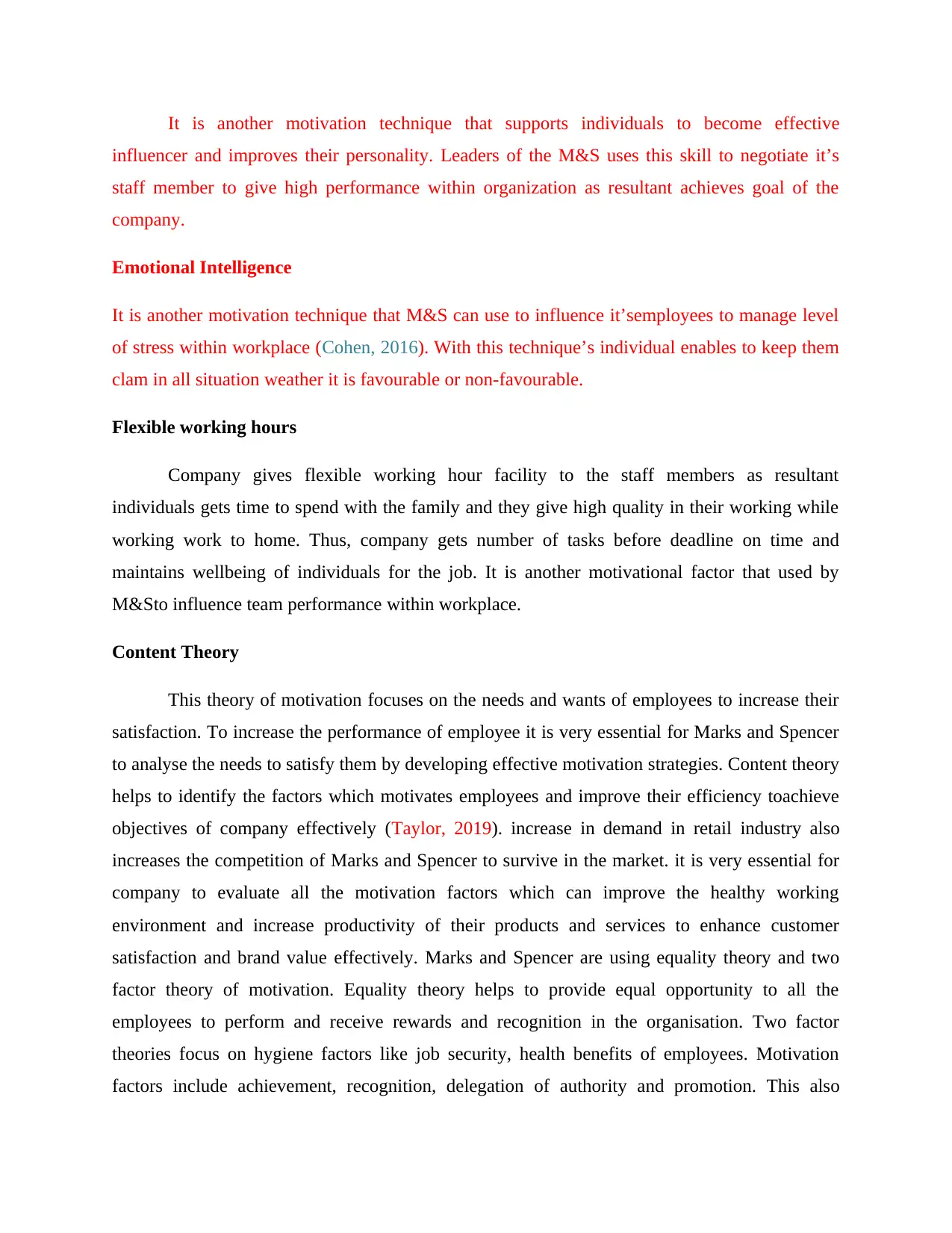
It is another motivation technique that supports individuals to become effective
influencer and improves their personality. Leaders of the M&S uses this skill to negotiate it’s
staff member to give high performance within organization as resultant achieves goal of the
company.
Emotional Intelligence
It is another motivation technique that M&S can use to influence it’semployees to manage level
of stress within workplace (Cohen, 2016). With this technique’s individual enables to keep them
clam in all situation weather it is favourable or non-favourable.
Flexible working hours
Company gives flexible working hour facility to the staff members as resultant
individuals gets time to spend with the family and they give high quality in their working while
working work to home. Thus, company gets number of tasks before deadline on time and
maintains wellbeing of individuals for the job. It is another motivational factor that used by
M&Sto influence team performance within workplace.
Content Theory
This theory of motivation focuses on the needs and wants of employees to increase their
satisfaction. To increase the performance of employee it is very essential for Marks and Spencer
to analyse the needs to satisfy them by developing effective motivation strategies. Content theory
helps to identify the factors which motivates employees and improve their efficiency toachieve
objectives of company effectively (Taylor, 2019). increase in demand in retail industry also
increases the competition of Marks and Spencer to survive in the market. it is very essential for
company to evaluate all the motivation factors which can improve the healthy working
environment and increase productivity of their products and services to enhance customer
satisfaction and brand value effectively. Marks and Spencer are using equality theory and two
factor theory of motivation. Equality theory helps to provide equal opportunity to all the
employees to perform and receive rewards and recognition in the organisation. Two factor
theories focus on hygiene factors like job security, health benefits of employees. Motivation
factors include achievement, recognition, delegation of authority and promotion. This also
influencer and improves their personality. Leaders of the M&S uses this skill to negotiate it’s
staff member to give high performance within organization as resultant achieves goal of the
company.
Emotional Intelligence
It is another motivation technique that M&S can use to influence it’semployees to manage level
of stress within workplace (Cohen, 2016). With this technique’s individual enables to keep them
clam in all situation weather it is favourable or non-favourable.
Flexible working hours
Company gives flexible working hour facility to the staff members as resultant
individuals gets time to spend with the family and they give high quality in their working while
working work to home. Thus, company gets number of tasks before deadline on time and
maintains wellbeing of individuals for the job. It is another motivational factor that used by
M&Sto influence team performance within workplace.
Content Theory
This theory of motivation focuses on the needs and wants of employees to increase their
satisfaction. To increase the performance of employee it is very essential for Marks and Spencer
to analyse the needs to satisfy them by developing effective motivation strategies. Content theory
helps to identify the factors which motivates employees and improve their efficiency toachieve
objectives of company effectively (Taylor, 2019). increase in demand in retail industry also
increases the competition of Marks and Spencer to survive in the market. it is very essential for
company to evaluate all the motivation factors which can improve the healthy working
environment and increase productivity of their products and services to enhance customer
satisfaction and brand value effectively. Marks and Spencer are using equality theory and two
factor theory of motivation. Equality theory helps to provide equal opportunity to all the
employees to perform and receive rewards and recognition in the organisation. Two factor
theories focus on hygiene factors like job security, health benefits of employees. Motivation
factors include achievement, recognition, delegation of authority and promotion. This also
⊘ This is a preview!⊘
Do you want full access?
Subscribe today to unlock all pages.

Trusted by 1+ million students worldwide
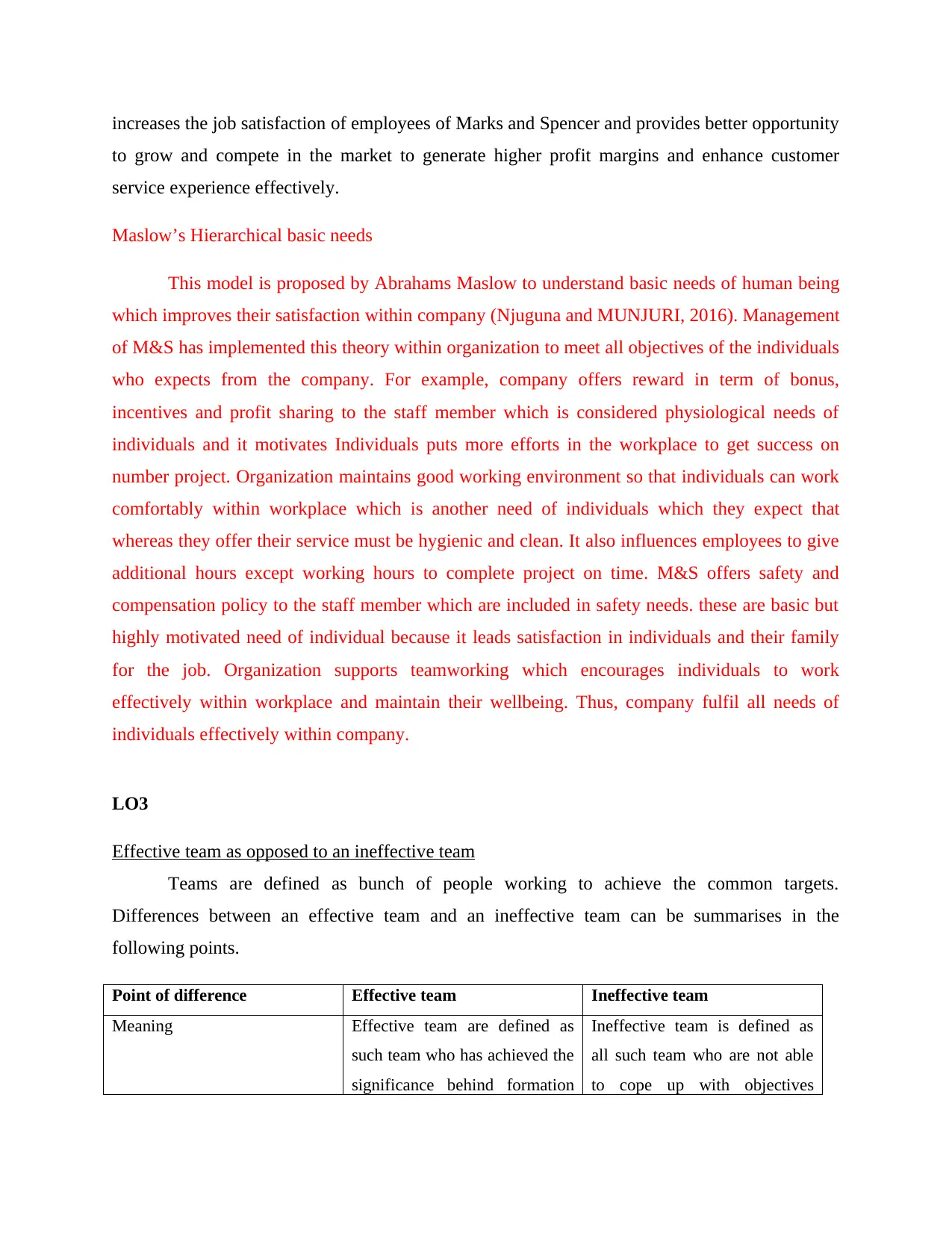
increases the job satisfaction of employees of Marks and Spencer and provides better opportunity
to grow and compete in the market to generate higher profit margins and enhance customer
service experience effectively.
Maslow’s Hierarchical basic needs
This model is proposed by Abrahams Maslow to understand basic needs of human being
which improves their satisfaction within company (Njuguna and MUNJURI, 2016). Management
of M&S has implemented this theory within organization to meet all objectives of the individuals
who expects from the company. For example, company offers reward in term of bonus,
incentives and profit sharing to the staff member which is considered physiological needs of
individuals and it motivates Individuals puts more efforts in the workplace to get success on
number project. Organization maintains good working environment so that individuals can work
comfortably within workplace which is another need of individuals which they expect that
whereas they offer their service must be hygienic and clean. It also influences employees to give
additional hours except working hours to complete project on time. M&S offers safety and
compensation policy to the staff member which are included in safety needs. these are basic but
highly motivated need of individual because it leads satisfaction in individuals and their family
for the job. Organization supports teamworking which encourages individuals to work
effectively within workplace and maintain their wellbeing. Thus, company fulfil all needs of
individuals effectively within company.
LO3
Effective team as opposed to an ineffective team
Teams are defined as bunch of people working to achieve the common targets.
Differences between an effective team and an ineffective team can be summarises in the
following points.
Point of difference Effective team Ineffective team
Meaning Effective team are defined as
such team who has achieved the
significance behind formation
Ineffective team is defined as
all such team who are not able
to cope up with objectives
to grow and compete in the market to generate higher profit margins and enhance customer
service experience effectively.
Maslow’s Hierarchical basic needs
This model is proposed by Abrahams Maslow to understand basic needs of human being
which improves their satisfaction within company (Njuguna and MUNJURI, 2016). Management
of M&S has implemented this theory within organization to meet all objectives of the individuals
who expects from the company. For example, company offers reward in term of bonus,
incentives and profit sharing to the staff member which is considered physiological needs of
individuals and it motivates Individuals puts more efforts in the workplace to get success on
number project. Organization maintains good working environment so that individuals can work
comfortably within workplace which is another need of individuals which they expect that
whereas they offer their service must be hygienic and clean. It also influences employees to give
additional hours except working hours to complete project on time. M&S offers safety and
compensation policy to the staff member which are included in safety needs. these are basic but
highly motivated need of individual because it leads satisfaction in individuals and their family
for the job. Organization supports teamworking which encourages individuals to work
effectively within workplace and maintain their wellbeing. Thus, company fulfil all needs of
individuals effectively within company.
LO3
Effective team as opposed to an ineffective team
Teams are defined as bunch of people working to achieve the common targets.
Differences between an effective team and an ineffective team can be summarises in the
following points.
Point of difference Effective team Ineffective team
Meaning Effective team are defined as
such team who has achieved the
significance behind formation
Ineffective team is defined as
all such team who are not able
to cope up with objectives
Paraphrase This Document
Need a fresh take? Get an instant paraphrase of this document with our AI Paraphraser
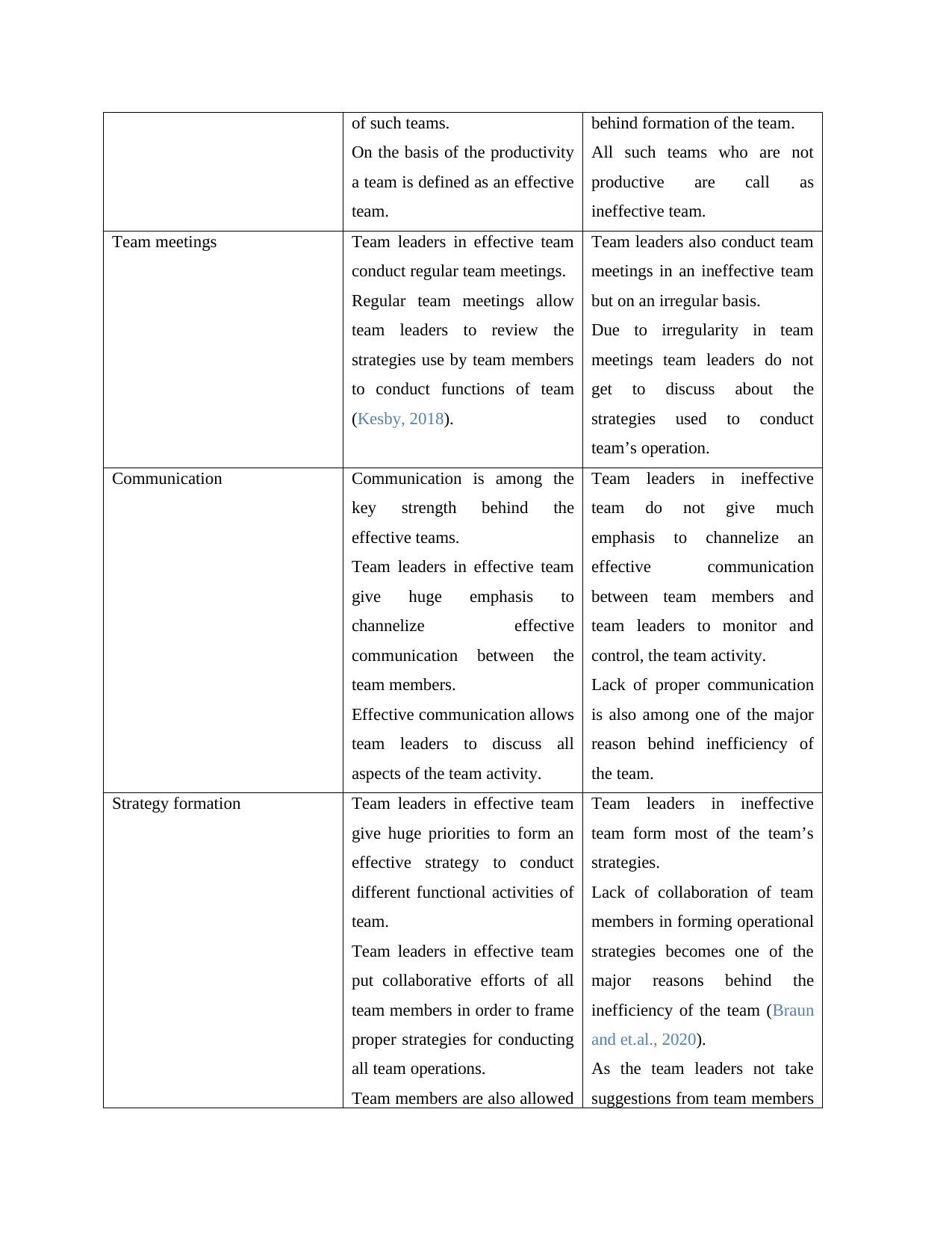
of such teams.
On the basis of the productivity
a team is defined as an effective
team.
behind formation of the team.
All such teams who are not
productive are call as
ineffective team.
Team meetings Team leaders in effective team
conduct regular team meetings.
Regular team meetings allow
team leaders to review the
strategies use by team members
to conduct functions of team
(Kesby, 2018).
Team leaders also conduct team
meetings in an ineffective team
but on an irregular basis.
Due to irregularity in team
meetings team leaders do not
get to discuss about the
strategies used to conduct
team’s operation.
Communication Communication is among the
key strength behind the
effective teams.
Team leaders in effective team
give huge emphasis to
channelize effective
communication between the
team members.
Effective communication allows
team leaders to discuss all
aspects of the team activity.
Team leaders in ineffective
team do not give much
emphasis to channelize an
effective communication
between team members and
team leaders to monitor and
control, the team activity.
Lack of proper communication
is also among one of the major
reason behind inefficiency of
the team.
Strategy formation Team leaders in effective team
give huge priorities to form an
effective strategy to conduct
different functional activities of
team.
Team leaders in effective team
put collaborative efforts of all
team members in order to frame
proper strategies for conducting
all team operations.
Team members are also allowed
Team leaders in ineffective
team form most of the team’s
strategies.
Lack of collaboration of team
members in forming operational
strategies becomes one of the
major reasons behind the
inefficiency of the team (Braun
and et.al., 2020).
As the team leaders not take
suggestions from team members
On the basis of the productivity
a team is defined as an effective
team.
behind formation of the team.
All such teams who are not
productive are call as
ineffective team.
Team meetings Team leaders in effective team
conduct regular team meetings.
Regular team meetings allow
team leaders to review the
strategies use by team members
to conduct functions of team
(Kesby, 2018).
Team leaders also conduct team
meetings in an ineffective team
but on an irregular basis.
Due to irregularity in team
meetings team leaders do not
get to discuss about the
strategies used to conduct
team’s operation.
Communication Communication is among the
key strength behind the
effective teams.
Team leaders in effective team
give huge emphasis to
channelize effective
communication between the
team members.
Effective communication allows
team leaders to discuss all
aspects of the team activity.
Team leaders in ineffective
team do not give much
emphasis to channelize an
effective communication
between team members and
team leaders to monitor and
control, the team activity.
Lack of proper communication
is also among one of the major
reason behind inefficiency of
the team.
Strategy formation Team leaders in effective team
give huge priorities to form an
effective strategy to conduct
different functional activities of
team.
Team leaders in effective team
put collaborative efforts of all
team members in order to frame
proper strategies for conducting
all team operations.
Team members are also allowed
Team leaders in ineffective
team form most of the team’s
strategies.
Lack of collaboration of team
members in forming operational
strategies becomes one of the
major reasons behind the
inefficiency of the team (Braun
and et.al., 2020).
As the team leaders not take
suggestions from team members
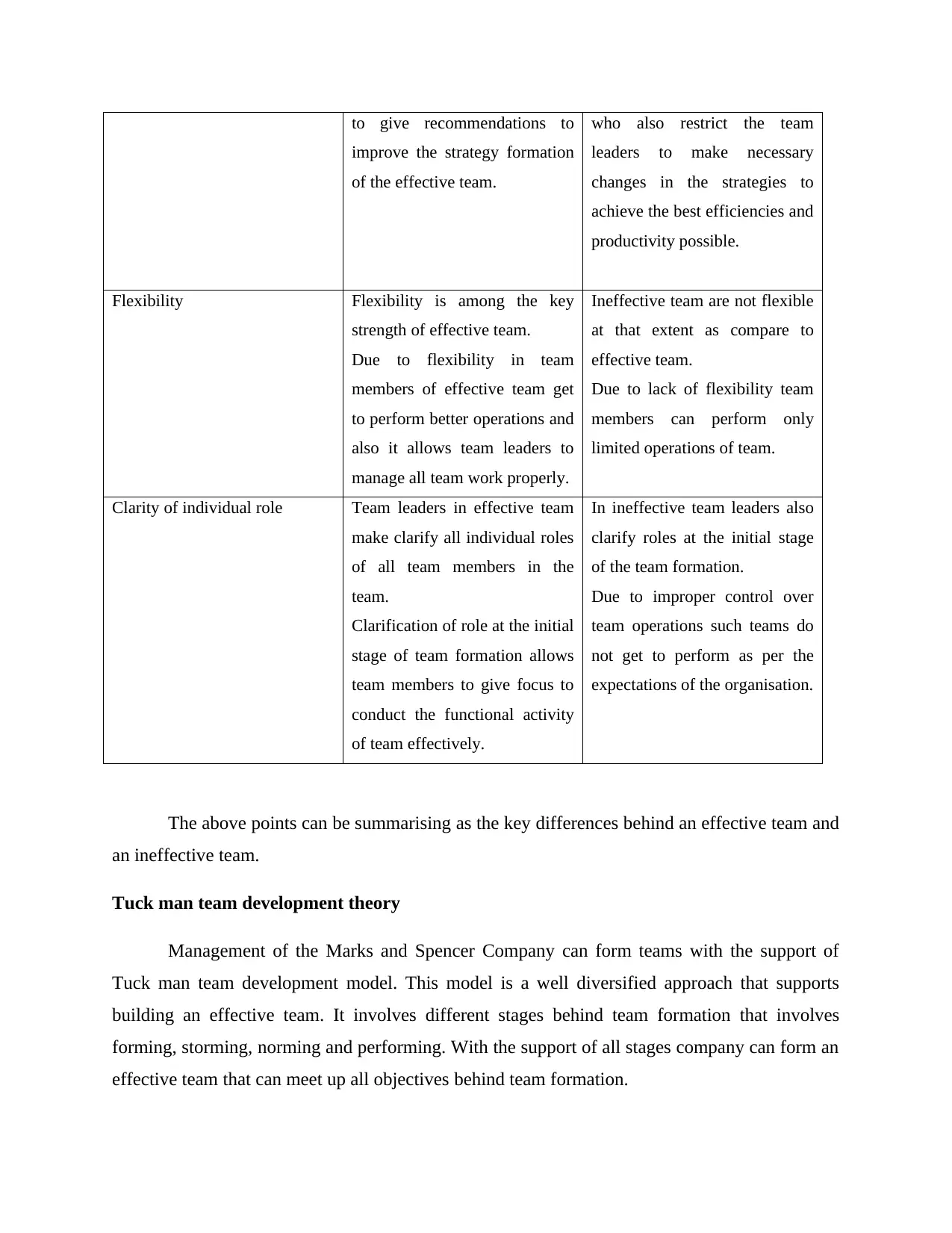
to give recommendations to
improve the strategy formation
of the effective team.
who also restrict the team
leaders to make necessary
changes in the strategies to
achieve the best efficiencies and
productivity possible.
Flexibility Flexibility is among the key
strength of effective team.
Due to flexibility in team
members of effective team get
to perform better operations and
also it allows team leaders to
manage all team work properly.
Ineffective team are not flexible
at that extent as compare to
effective team.
Due to lack of flexibility team
members can perform only
limited operations of team.
Clarity of individual role Team leaders in effective team
make clarify all individual roles
of all team members in the
team.
Clarification of role at the initial
stage of team formation allows
team members to give focus to
conduct the functional activity
of team effectively.
In ineffective team leaders also
clarify roles at the initial stage
of the team formation.
Due to improper control over
team operations such teams do
not get to perform as per the
expectations of the organisation.
The above points can be summarising as the key differences behind an effective team and
an ineffective team.
Tuck man team development theory
Management of the Marks and Spencer Company can form teams with the support of
Tuck man team development model. This model is a well diversified approach that supports
building an effective team. It involves different stages behind team formation that involves
forming, storming, norming and performing. With the support of all stages company can form an
effective team that can meet up all objectives behind team formation.
improve the strategy formation
of the effective team.
who also restrict the team
leaders to make necessary
changes in the strategies to
achieve the best efficiencies and
productivity possible.
Flexibility Flexibility is among the key
strength of effective team.
Due to flexibility in team
members of effective team get
to perform better operations and
also it allows team leaders to
manage all team work properly.
Ineffective team are not flexible
at that extent as compare to
effective team.
Due to lack of flexibility team
members can perform only
limited operations of team.
Clarity of individual role Team leaders in effective team
make clarify all individual roles
of all team members in the
team.
Clarification of role at the initial
stage of team formation allows
team members to give focus to
conduct the functional activity
of team effectively.
In ineffective team leaders also
clarify roles at the initial stage
of the team formation.
Due to improper control over
team operations such teams do
not get to perform as per the
expectations of the organisation.
The above points can be summarising as the key differences behind an effective team and
an ineffective team.
Tuck man team development theory
Management of the Marks and Spencer Company can form teams with the support of
Tuck man team development model. This model is a well diversified approach that supports
building an effective team. It involves different stages behind team formation that involves
forming, storming, norming and performing. With the support of all stages company can form an
effective team that can meet up all objectives behind team formation.
⊘ This is a preview!⊘
Do you want full access?
Subscribe today to unlock all pages.

Trusted by 1+ million students worldwide
1 out of 20
Related Documents
Your All-in-One AI-Powered Toolkit for Academic Success.
+13062052269
info@desklib.com
Available 24*7 on WhatsApp / Email
![[object Object]](/_next/static/media/star-bottom.7253800d.svg)
Unlock your academic potential
Copyright © 2020–2025 A2Z Services. All Rights Reserved. Developed and managed by ZUCOL.





